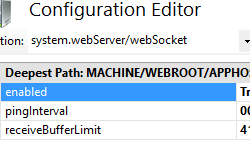
Best and Reliable ASP.NET 4.5 Websocket Hosting Recommendation
ReliableASPNETHosting.com | Best and reliable ASP.NET 4.5 Websocket hosting. WebSocket is a recent technology that provides two-way communication over a TCP connection. This allows us to create real-time web apps where servers can push data to clients. In this blog post, I’ll demonstrate how this can be done by building a simple chat app using ASP.NET WebAPI and ASP.NET’s new support for WebSockets in .NET 4.5.
The <webSocket> element specifies the use of the WebSocketModule module with ASP.NET 4.5 to support writing server applications that communicate over the WebSocket Protocol. WebSocket enables you to provide full-duplex communications over a single TCP connection by using a stream of messages rather than a stream of bytes. This makes it easier to connect to data sources asynchronously in cloud deployments.
How To find The Best and Reliable ASP.NET 4.5 Websocket hosting
After we reviewed 50+ Windows web hosting solutions thoroughly, we finally come out the best ASP.NET 4.5 Websocket hosting providers in below chart, based on our real testing experience and verified customer feedbacks.
After the in-depth review and comprehensive analysis, we rank out the best ASP.NET 4.5 Websocket hosting providers as ASPHostPortal, HostForLIFE, DiscountService and UKWindowsHost. To choose the best windows hosting for yourself, we recommend you reading the web hosting reviews and disclose as below. You won’t go wrong with them.
Best and Reliable ASP.NET 4.5 WebSocket hosting
| Hosting Sites |
Unlimited |
Unlimited |
Unlimited |
1 |
| Disk Space |
5 GB |
Unlimited |
2 GB |
1 GB |
| Bandwidth |
60 GB |
Unlimited |
20 GB |
20 GB |
| Uptime |
99.90% |
99.90% |
99.90% |
99.90% |
| Control Panel |
Plesk |
Plesk |
Plesk |
Plesk |
| Technical Features | ||||
| Platform |
Windows 2012 R2 |
Windows 2012 R2 |
Windows 2012 R2 |
Windows 2012 R2 |
| ASP.NET |
2.0/3.5SP1/4.5.2/5 |
2.0/3.5SP1/4.5.2/5 |
2.0/3.5SP1/4.5.2/5 |
2.0/3.5SP1/4.5.2/5 |
| ASP.NET MVC |
2.0/3.0/4.0/5.0/6.0 |
2.0/3.0/4.0 |
2.0/3.0/4.0 |
2.0/3.0/4.0 |
| IIS |
8.5 |
8.5 |
8.5 |
8.5 |
| Trust Level |
Full |
Full |
Full |
Full |
| URL Rewrite |
MS URLRewrite2 |
MS URLRewrite2 |
MS URLRewrite2 |
MS URLRewrite2 |
| Total MSSQL |
1 |
1 |
1 |
– |
| MSSQL Space |
50 MB |
50 MB |
100 MB |
– |
| MSSQL Version |
SQL Server 2014/2012/2008R2 |
SQL Server 2014/2012/2008R2 |
SQL Server 2014/2012/2008R2 |
SQL Server 2014/2012/2008R2 |
| Remote MSSQL |
Yes |
Yes |
Yes |
Yes |
| Total MySQL |
1 |
1 |
1 |
1 |
| MySQL Space |
100 MB |
100 MB |
100 MB |
100 MB |
| MySQL Version |
5.x |
5.x |
5.x |
5.x |
| PHPMyAdmin |
Yes |
Yes |
Yes |
Yes |
| Email Specification | ||||
| Accounts |
Unlimited |
Unlimited |
Unlimited |
Unlimited |
| Storage |
200 MB |
200 MB |
200 MB |
500 MB |
| IMAP |
Yes |
Yes |
Yes |
Yes |
| POP3 |
Yes |
Yes |
Yes |
Yes |
| SMTP |
Yes |
Yes |
Yes |
Yes |
| Anti Spam |
Yes |
Yes |
Yes |
Yes |
| Anti Virus |
Yes |
Yes |
Yes |
Yes |
| Webmail |
Yes |
Yes |
Yes |
Yes |
How to configure WebSocket
- Open Internet Information Services (IIS) Manager:
- If you are using Windows Server 2012 or later:
- On the taskbar, click Server Manager, click Tools, and then click Internet Information Services (IIS) Manager.
- If you are using Windows 8 or later:
- Hold down the Windows key, press the letter X, and then click Control Panel.
- Click Administrative Tools, and then double-click Internet Information Services (IIS) Manager.
- If you are using Windows Server 2012 or later:
- In the Connections pane, select the server name to configure WebSocket for the server, or expand Sites and then select a site to configure WebSocket for the site, or expand a site and then select an application to configure WebSocket for the application.
- In the Home pane, double-click the Configuration Editor feature.
- For either a site or an application, select either web.config or applicationHost.config in the From text box.
- Select system.webServer/webSocket in the Section text box.
- Set
enabledto True to enable webSocket or False to disable webSocket. Set pingInterval and receiveBufferLimit to the desired values.

7. Click Apply in the Actions pane.
Configuration
The <webSocket> element is configured at the server, site, or application level.
Attributes
| Attribute | Description |
|---|---|
enabled |
Optional Boolean attribute.
Enables server applications to communicate over the WebSocket protocol. The default value is |
pingInterval |
Optional timeSpan attribute.
The interval at which a ping is sent over a WebSocket connection. The default value is |
receiveBufferLimit |
Optional uint attribute.
The maximum size of the receive buffer for a WebSocket connection. The default value is |
Child Elements
None.
Configuration Sample
The following sample displays a <webSocket> element.
<system.webServer>
<webSocket
enabled="filename.htm"
receiveBufferLimit="true"
pingInterval="00:01:00">
</webSocket>
</system.webServer>
Sample Code
The following sample code configures <webSocket> for a site.
AppCmd.exe
appcmd.exe set config "Default Web Site" -section:system.webServer/webSocket /enabled:"True" /receiveBufferLimit:"4194304" /pingInterval:"00:00:10" /commit:apphost
Note: You must be sure to set the commit parameter to apphost when using AppCmd.exe to configure these settings. This commits the configuration settings to the appropriate location section in the ApplicationHost.config file.
C#
using System;
using System.Text;
using Microsoft.Web.Administration;
internal static class Sample {
private static void Main() {
using(ServerManager serverManager = new ServerManager()) {
Configuration config = serverManager.GetApplicationHostConfiguration();
ConfigurationSection webSocketSection = config.GetSection("system.webServer/webSocket", "Default Web Site");
webSocketSection["enabled"] = true;
webSocketSection["receiveBufferLimit"] = 4194304;
webSocketSection["pingInterval"] = TimeSpan.Parse("00:00:10");
serverManager.CommitChanges();
}
}
}










